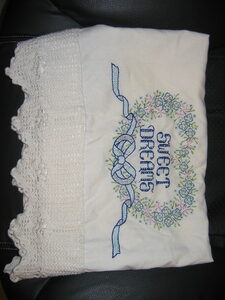Any parent who has had little kids knows the importance of having fresh pillowcases on hand. Parents of toddlers especially change pillowcases often due to drooling. A dirty pillowcase can cause blemishes on your child’s face. An un-fresh pillowcase can also collect allergens such as dust and trigger allergies in your little ones. The allergies may be unknown. A dirty pillowcase actually could give your child a runny or stuffy nose and you’d not know it. It’s important to freshen and change them often. Twice a week or more often for younger children. Once or twice a week for older children. Daily for sick children of any age.
Buying pillowcases can be costly. The simple and plain ones are expensive, let alone the decorative ones. Parents want decorative pillowcases for their boys and girls rooms. The need to change them more frequently leads to a need to have more on hand. The more you need to have on hand the more you need to buy. Once again, buying pillowcases can be costly.
There is a way to have all the pillowcases you need without having to pay an arm and a leg for them. You can make your own pillowcases at home for your boys and girls bedding needs. It is really remarkably simple to do. Pillowcases can be made for boys and girls alike. Here’s how…
The first thing you do is dig out that box of fabric you have in your craft room, or stored away. Maybe you’re an avid crafter and have it right and ready! If you simply have no fabric on hand then you’ll need to pick some up. Your local craft store will have all you need. It is very inexpensive for the amount you need to make a pillowcase with. Much cheaper than buying a package of pillowcases. You can make about ten pillowcases for the price you’d pay for a set of two.
Choose your fabric! Boys love sports themes, animals, and bright, bold color patterns or stripes. Girls love soft, pastel, flowery, pretty prints and patterns. Fabrics are available in an extremely wide array of colors, patterns, textures, styles, etc. The amount of fabric you purchase depends on how many pillowcases you’ll like to make. If you want to make several then buy a few yards. Remember though when choosing your fabric that it should be soft as your child’s face will be against it all night long. Cotton really is best. Satin, silky fabric are gentle and nice too.
The next thing you’ll need to do is to measure your child’s pillow. You can use a ruler, or a tape measure. I will let you know that the average pillow is about 17-18 inches by 23-24 inches in length. The average toddler sized pillow is about 7-8 inches wide by 14-15 inches in length. Little ones don’t usually have pillows that are very large so we won’t worry about how big they are. However, if your pillow seems larger or smaller than these measurements you’ll need to adjust the size you cut your fabric.
Wait! Don’t cut that fabric yet. You first need to prepare. The next step is to do just that. Find a clean, large, flat surface and spread your fabric out. It will need to be folded in half. Each half needs to be a little bit larger than the pillow itself. Before you actually lay your fabric down hold it up in front of you. Fold is exactly in half so that the pattern is on the INSIDE. Leave the fold as a seem. The fold should run lengthwise. The long side of the rectangle. You will not cut along that fold. You can use fabric tape or even masking tape to tack it down to the surface to prevent it from slipping and moving. Then you’ll want to find a pencil. There are special fabric marking pencils and such available but honestly a regular pencil works too. So does a piece of your children chalk.
Take those measurements of the actual pillow size and increase them by two to three inches on each side, two if you like them to fit tightly, three if you like them a little loose. Some people like to increase the length by two up to four inches so that it kind of comes together at the end once the pillow is inserted. The reason why the fabric must be larger than the actual pillow itself is because the pillow has bulk to it too. The extra inches of fabric hold the bulk and let the pillow fit inside. Something can not fit inside of something else that is it’s same exact size especially when thickness is not taken into consideration. Adding inches is taking the thickness of the pillow into consideration. Therefore, a thin pillow is good at one inch per side where a super thick pillow may require three.
Once you have your fabric all marked out you are ready to cut. Now you’ll need to remove the tape that’s holding your fabric down. This should be done one side at a time, as it is cut. Be careful not to disturb the alignment of your fabric as it is only marked on one side and must stay together as it was when marked. Removing the tape one side at a time helps to prevent any disruption. The smartest thing to do is to insert common pins one half inch all the way around, on each side except the fold of course. Then undo the tape.
Yeah! It’s time for the fun to begin. Get your needle and thread ready. Choose a thread color that matches and blends in with the fabric. Get ready, get set, sew!
Begin on the bottom end. The opposite end of witch the pillow is inserted. This end will be the closed end where the other is the open one. Stitch it in tiny “——-” stitches just like that. Go all the way across the bottom. Make a knot and cut your threat. To make a good knot and tie off your thread so that it will not unravel simply stitch the same spot five times, bringing the needle up and under the thread to create a know as you pull the stitch through.
Freshen that needle up again and pick a side, either side. Stitch it up just the same way you do the bottom but stop one inch before you reach the end. Tie off. Go to the other side with fresh needle and thread. Do it just the same.
Next go to that open end with fresh needle and thread. You are NOT going to sew it together. Rather, lay your case out in front of you. Get your iron. The one you iron laundry with to remove wrinkles. Fold the edge of the fabric out towards you one quarter of an inch. Iron the fold to create a seem. Insert common pins. Then stitch across and do the exact same to the other side.
You are almost to the last step of creating the pillowcase for your boy or girl. The color of the print of the fabric you use determines whether the case if for a boy or a girl. Now you’re done sewing and it’s time to remove all of the common pins. You then turn it right side out and look at it! You have just learned how to create your own pillowcases for your boys or girls out of the decorative fabric that you buy for so much less than a bunch of pillowcases would cost!


